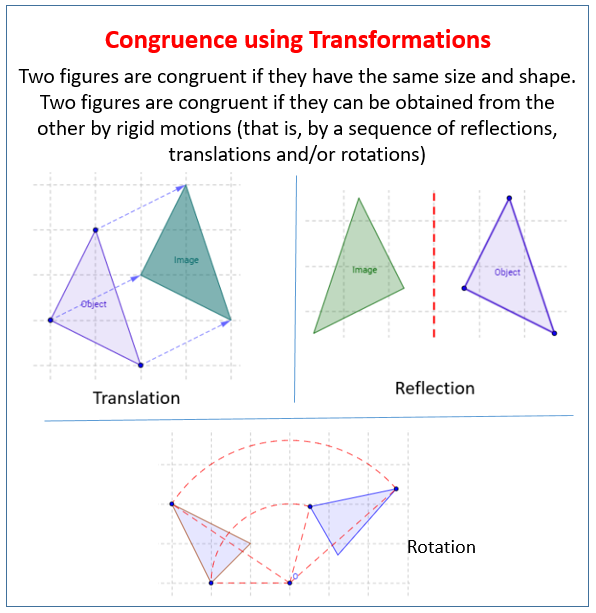Congruence & Transformations
Common Core: HSG-CO.B.6
Related Topics:
Common Core (Geometry)
Common Core for Mathematics
Examples, solutions, and lessons to help High School students learn how to use geometric descriptions of rigid motions to transform figures and to predict the effect of a given rigid motion on a given figure; given two figures, use the definition of congruence in terms of rigid motions to decide if they are congruent.
Two figures are congruent if they have the same size and shape.
Two plane figures are congruent if they can be obtained from the other by rigid motions (that is, by a sequence of reflections, translations and/or rotations)
The following diagrams show the transformations that keep the figures congruent (same size and shape). Scroll down the page for more examples and solutions.

Congruence Using Transformations: Demonstrate G-CO.6
This video demonstrates congruence using transformations.
The Common Core State Standards for Mathematics are 8.G.2 and G-CO.6.
Congruence Using Transformations: Demo G-CO.6 with a Reflection
This video demonstrates congruence using transformations. This video uses a reflection - because the orientation of triangles are reverses. The Common Core State Standards for Mathematics are 8.G.2 and G-CO.6.
Perform Congruence Transformations
Congruence & Transformations
Try out our new and fun Fraction Concoction Game.
Add and subtract fractions to make exciting fraction concoctions following a recipe. There are four levels of difficulty: Easy, medium, hard and insane. Practice the basics of fraction addition and subtraction or challenge yourself with the insane level.

We welcome your feedback, comments and questions about this site or page. Please submit your feedback or enquiries via our Feedback page.